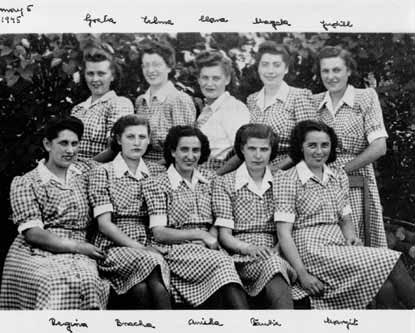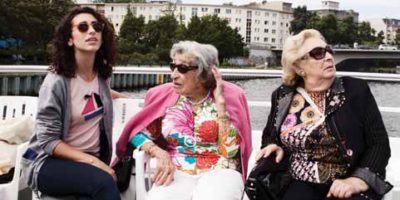The Gingham Dresses

This photo was always displayed in her living room.
In my grandparents’ house, a 1950s rambler in Toronto’s Downsview neighborhood, nearly every surface was decorated with photos: children, grandchildren, great-grandchildren; bar and bat mitzvahs, graduations, weddings. One black-and-white photo, though, stood starkly apart: 10 young women, in two rows like a class picture, all wearing the same gingham dresses. I was always captivated by the photo, and inspected it whenever I came to visit. I knew that my grandmother, Judith, was the girl at the top right. In fact, I knew all their names because my grandma wrote them in the margins. I was both fascinated and troubled by Clara, the woman in the middle, the only one wearing a white blouse.
The photograph was taken on May 5, 1945, after Judith and nine women with whom she’d survived Auschwitz were liberated by American soldiers and brought to live in former Nazi headquarters in Schwerin, Germany. The soldiers visited almost daily, bringing food from their own rations. The “girls,” as my grandma called them, slowly gained weight and their hair began to grow back. One of the soldiers, who was Jewish, took extra care of Judith. “He wanted to adopt me,” she liked to say.
One day the soldier asked Judith if he could get her anything special.
“Yes,” she said shyly. “I would love a sewing machine and a little fabric.”
Grandma would explain to me, “You see, Alisha, we only had shmatas to wear.”
The soldier found an old sewing machine and blue-and-white checkered bed sheets from an abandoned SS barracks. Before the war, Grandma had supported her family by working as a seamstress; now she threw herself into the task of making dresses.
“You see the puffed-up sleeves, mamaleh? How the collars come down into those lovely points?” she once asked me, the photo held up close for my inspection. “See how the pattern runs diagonal here on the breast pockets?” She wanted the dresses to be stylish, she said. I told her that they were, that they looked like something a ladies’ folk-singing group might buy at the Hudson’s Bay Company.
“Was the girl in the white blouse the leader of the group?” I remember asking.
“No,” Grandma said, laughing. “The poor soul arrived late and there wasn’t enough material!”
Today is my grandmother’s yahrzeit, marking one year since her death. In memoriam, I find myself studying this photo, this photo in which my grandma is exactly my age. I long to hear her animated voice telling me about the “girls,” the predictable pauses she used for emphasis, the way she brushed over her pain with calm cordiality.
Suddenly I yearn for every particular. Why did Clara arrive in Schwerin late, Grandma? Did you stay in touch with these women? Did they scatter across the globe? Are any of them still alive? Do they have granddaughters?
What was the name of the soldier? Did you ever contact him after you left Schwerin? Grandma, what was it like to cut up Nazis’ bed sheets? To wear fabric on which monsters had sweated and slept? What was all of it like?
When we used to look at this photograph together, side-by-side at the kitchen table, my grandma would tell me, “On this day, mamaleh, we began to be humans.”
Alisha Kaplan is a poet and short story writer whose work has appeared in Carousel, The New Quarterly, Branch, The Irish Literary Review, and elsewhere. A native of Toronto, she now lives in Brooklyn. alishakaplan.com


